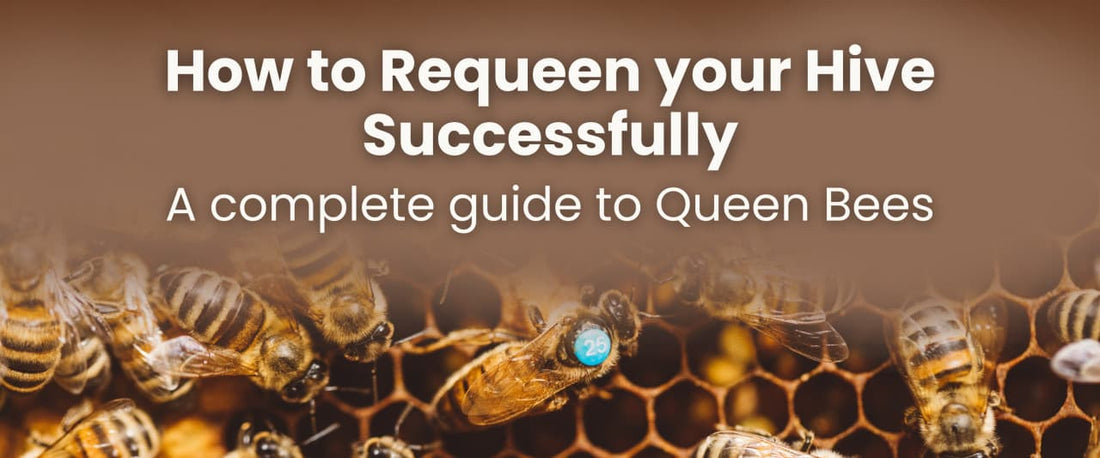
How to Requeen your hive successfully - A complete guide to Queen Bees
The queen bee is the most important member of a bee colony - responsible for its survival and reproduction, regulates the behaviour of the colony, and keeps it united. The success of a hive is entirely dependent upon the well-being of its queen, so beekeepers need to closely look into its performance and overall health during each inspection. When the queen of the hive dies or slows down, it becomes necessary to replace her for the growth and survival of the colony.
This guide will help you understand the significance of queen bees, the optimal time to requeen your hive, and practical methods for requeening successfully.

Why Your Hive Needs a New Queen
Queen bees usually have a lifespan of 2-3 years, but some might live for up to 5 years. In a hive, a queen lays thousands of eggs per day and produces pheromones that regulate the colony's behaviour and help her communicate with worker bees. As the queen ages, her ability to reproduce and maintain the hive declines, affecting the overall health of the hive. Queen bee replacement becomes the only choice for beekeepers, and some do it every 1 or 2 years to keep the hive in optimal condition.
In Australia, the best times to requeen are early spring or fall. These are the periods of active foraging - potent pollen and nectar flow, which help worker bees accept a new queen easily. A general rule is that beekeepers look for the signs; if the queen is still strong and the hive is flourishing, you can stick around a little longer. But you should always have a backup plan - have access to a new queen from a reputable breeder for urgent needs.
Consider adding a new queen bee if you find these signs positive in your colony.
- Dwindling population: Fewer eggs lead to a weaker hive.
- Aggressive hive behaviour: Reduced pheromone levels signal instability within the hive, promoting aggressive behaviour in bees.
- Scattered brood pattern: Suggests fertility issues or an infertile queen.
- Unwanted drones: A feeble queen may produce too many drones.
- Improved genetics: You might want to enhance the traits of the hive by introducing a new queen with improved disease resistance and docile temperament.
- An aging queen: A queen aging 1-2 years may become weak and no longer perform well.
Requeening a beehive - Step by Step Guid
-
Remove the old Queen - Identify and remove the old queen. Beekeepers usually discard her, as the hive does not accept a new queen while the old one still exists.
-
Keep the hive queenless - Queenlessness for a short period of time can help bees readily accept the new queen. Mostly, beekeepers keep the hive queenless for about 12-24 hrs.
-
During inspections, look for emergency queen cells and destroy them so that the bees have no hope of a queen in the hive. This helps them easily accept the new queen you want to introduce.
-
Requeen the hive - Introduce the new queen by placing her in the introduction cage between two brood frames. The worker bees will keep her warm and fed, while the hive will get used to her pheromones.
-
Give time to release - Hold the inspections for some time (almost 1 week) so that the hive remains undisturbed. The worker bees gradually chew the candy plug, finally releasing the queen into the hive.
-
Inspect the hive for acceptance - Check after a week whether the new queen is laying eggs to confirm successful introduction.
This slow and careful method gives the best results with higher chances of the hive accepting the new queen.
What To Expect After Requeening Your Hive
After the successful introduction of a new queen to your hive, you might see:
- A stronger and growing colony
- Docile temperament of the hive
- Reduced swarming
- Improved hive health
- Better honey harvests
Requeening a beehive is a valuable skill every beekeeper develops over time. Careful hive inspections can help beginners recognise when their colony needs a queen bee replacement. By learning how to requeen a hive at the right time, you can ensure better health and productivity of your bees, while keeping them calm and more manageable. Simply put, adding a new queen bee to a struggling colony can help you transform it into a balanced, thriving hive.
Sometimes, finding the right queen can be quite a daunting task, but trusted suppliers like Beekeeping Gear make the process easier by offering high-quality, well-bred queens. It ships Italian queens to beekeepers around Australia, simplifying queen replacement. So, whenever your hive shows signs of decline, do not hesitate to requeen your colony timely. This decision might turn out to be the best one for the well-being of your bees.

